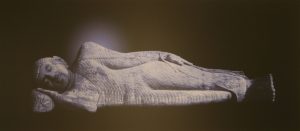
Paranirvana Study (Blue), 2007
Pigment inks on moab entrada paper
© 2021 Lewis De Soto
Samek Art Museum Collection
2007.13
From the Greek ek (out) and phrazein (to speak), ekphrasis is a written description of or response to a work of visual art. Samek Museum Guide Joshua Garcia, an incoming Stadler Fellow at Bucknell University’s Stadler Center for Poetry and Literary Arts, shares an ekphrastic poem responding to an artwork in the Samek’s permanent collection. This week, Garcia’s poem explores Lewis deSoto’s Paranirvana Study (Blue), a photographic study of deSoto’s sculptural installation which depicts the artist’s face on an inflatable Buddha at the moment of his death and release from the karmic cycle of rebirth.
Paranirvana Study (Blue)
after Lewis deSoto
I was once advised it is no good to end a poem with a discordant statement: God is dead.
(This is not a performance.)
So I will begin this poem by telling you that I pressed my ear to a chest that emptied like a bell.
Desire does not cease. It compacts like sand into stone. Spreads out like sea foam
thinning into bursts of air.
The last thing I have faith in: Winter becomes spring. The oleanders are hot,
and the distance between us lies out long and blue. We will be so lucky if there is no paradise
on the other side of this.
The shape of wind can be seen by hanging up a sheet, and a lie can be honest if believed.
In the end, superimpose kisses onto my eyelids. Collect our voices in a bag and let them jangle.
(This is the sound of leaving.)
Let a polyphonic breath lift me like a weightless thing. Let my rejection be complete.
By: Joshua Garcia

